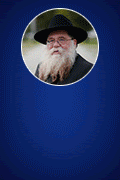With ice cream sundaes, iPod giveaways, spa days and yoga classes, a group of Orthodox rabbis in the Washington area is employing decidedly unorthodox methods to address a growing problem: the fading involvement of Jews in local Jewish life.
Although the region has one of the largest and youngest Jewish communities in the country, recent studies have found that a shrinking proportion of Jews-- as elsewhere in the country — is joining synagogues, community centers, Jewish schools and other centers of Jewish life.
The Offbeat Is Helping Some Jews Reconnect
Chabad Rabbis’ Modern Outreach Methods Are Controversial but Forge Ties
With ice cream sundaes, iPod giveaways, spa days and yoga classes, a group of Orthodox rabbis in the Washington area is employing decidedly unorthodox methods to address a growing problem: the fading involvement of Jews in local Jewish life.
Although the region has one of the largest and youngest Jewish communities in the country, recent studies have found that a shrinking proportion of Jews– as elsewhere in the country — is joining synagogues, community centers, Jewish schools and other centers of Jewish life.
However, Chabad-Lubavitch, a controversial 250-year-old branch of Judaism with mystic roots, has significantly increased its presence in the area in the past five years. During that time, five gathering places — called Chabad Houses — have opened: two in Northern Virginia, two in northern Montgomery County and one in Annapolis. Rabbi Shmuel Kaplan, regional director of Chabad-Lubavitch of Maryland, said the movement expects further expansion.
“People ask me who our target audience is,” he said. “It’s every single Jew in metropolitan Washington.”
With their black hats, thick beards and long, black coats, male “Chabadniks” look like throwbacks to Old Europe. They are part of the movement called Hasidism, whose members — men and women — ordinarily live apart from mainstream society to shelter their beliefs and practice.
Not the followers of Chabad (pronounced similarly to ‘kah-BAHD’). The Brooklyn-based group emphasizes outreach to practicing and non-practicing Jews.
But the group has also engendered deep resentment from many mainstream Jews, who regard them as hovering on the far fringes of the faith.
Although Chabad-Lubavitch practitioners do not seek to convert non-Jews, mainstream Jews regard their outreach as evangelizing, a practice frowned upon. Critics also dismiss Chabad’s outreach as superficial and say its leaders are too quick to claim success.
“They’re offering a motel Judaism, not a home Judaism,” said Jacob Neusner, a professor and senior fellow at Bard College’s Institute of Advanced Theology in New York. “They rely on intense experiences which last for a little bit of time and don’t really have a permanent effect.”
Another source of controversy, inside and outside the movement, has been the belief on the part of some followers of Chabad that a revered leader, Rabbi Menachem M. Schneerson, who died in 1994, will return as the Messiah.
Despite the strife, Chabad is one of the fastest-growing major movements of Judaism, said Jonathan Sarna, professor of American Jewish history at Brandeis University. In the past decade, the number of Chabad’s emissaries has doubled worldwide to 4,000 rabbis and their families, said Rabbi Zalman Shmotkin, a national Chabad spokesman.
In the Washington area, where Chabad has operated since the 1970s, there are 13 Chabad Houses, offering a mix of New and Old World programs to draw in Jews who are not affiliated with synagogues. Chabad Houses — which are funded by donations, not membership dues — schedule worship services, religious classes for adults and children and holiday celebrations.
The Chabad Center of Potomac holds a periodic “spa for the soul” day for women featuring pedicures, cooking lessons and Torah study. The Chabad of Anne Arundel County runs a kosher delivery service — http://www.kosherkaptain.com– for the growing Jewish community there. In December, the Chabad House in Tysons Corner hosted a “Hannukah Wonderland” party in an office building, which attracted 2,500.
Last fall at Chabad of Silver Spring, Rabbi Berel Wolvovsky offered a free iPod to any child who attended his new Sunday morning Hebrew classes. This month, Wolvovsky presented eight children with their iPods.
“We could have given a discount to the parents for the tuition,” Wolvovsky said. But, he added, “our objective was that the kid should be excited about school.”
As in other Jewish communities in the country, local leaders are concerned lagging enthusiasm for social and religious organizations.
A 2003 survey found that although 90 percent of Washington area Jews reported engaging in individual religious practices — observing Passover and lighting Sabbath candles, for example — measures of participation in communal Jewish life are alarmingly low.
Just over a third of local Jewish households said they belonged to a synagogue– well below the average for 50 other Jewish communities nationwide, according to the 2003 survey, commissioned by the Charles I. & Mary Kaplan Family Foundation.
Enrollment in Jewish preschools and day schools was also well below average in the Washington area compared with other similarly sized Jewish communities. And a relatively high proportion — 41 percent — of marriages among Jews were found to be interfaith. Even more worrying to Jewish leaders was the finding that just one-half of area Jews said they felt a part of the local Jewish community.
Misha Galperin, chief executive of the Jewish Federation of Greater Washington, calls that a crisis.
“Unless we figure out how to handle it,” said Galperin, “the sense of us being a community of people who are connected to each other, to a set of values, is very much threatened.”
A 2004 study by the Jewish Outreach Institute laid the blame for the low participation at least partly on local Jewish organizations’ outreach, particularly to singles and families consisting of both Jewish and non-Jewish faiths.
Costs of memberships at synagogues and community centers are often high, it said. And some newcomers have been met with “apathy or boredom, or worse, rudeness or even hostility.”
To combat the problem, the Jewish Federation launched a multimillion-dollar effort last year to boost the proportion of Jews who say they feel a part of the local Jewish community to two-thirds within the next decade. Among its efforts: sponsoring festivals of Jewish culture, subsidizing synagogue memberships and encouraging Jewish groups to establish a presence at non-Jewish venues, such as street fairs.
Chabad “has been a very good teacher for us,” Galperin said. “They have been focused on outreach for a long time, and they’ve done things I think really are admirable and work very well.’
Rabbi Levi Deitsch and his wife, Miriam, set up a Chabad group in Tysons Corner in 2002, at first working out of their apartment and renting space for larger events, such as their Hannukah party.
Last year, they rented a brick rambler on a busy corner of Route 123, a major commuter thoroughfare into Tysons, where they offer classes and services six days a week. They store the Torah in a small cherry hutch that serves as the Ark and serve coffee and cake in the kitchen after services and classes. They attract several dozen each week to religious services and packed in 70 people for last month’s Passover Seder.
Recently, two dozen people settled into the small living room for a weekly class on Jewish history, taught by Deitsch.
It is one of several classes offered by Chabad’s adult educational arm, the Jewish Learning Institute, which designs the curriculum and sends out PowerPoint templates to its rabbis.
Stocky and cheerful, Deitsch, 33, wielded a laser pointer at the screen as he moved briskly through his presentation on anti-Semitism in Medieval Europe.
Like many Orthodox Jews, he refrains from physical contact — such as shaking hands — with women not related to him, and he shuts down his ever-present Palm Pilot as part of his observance of the Sabbath, which runs from sundown Friday until sundown Saturday.
But his approach in other areas is more relaxed. He conforms with the Orthodox practice of separating the sexes during religious services, so he plops down plastic potted plants on tables in the middle of the room to create a partition. He doesn’t want to scare anyone away.
”Judaism is made for everybody, and everybody is entitled to it,“ he said. ”Just because they weren’t brought up in a temple doesn’t mean they can’t participate.”














ashirah
its great to see the impact that chabad has (as usual) but the tone of this article really bothers me… its makes it sound like chabad is this commercialized religion. thats not what we’re about!
concerned
I really relate to what Ashira said above.
We have to keep the “PR” of being spiritual people of the Rebbe and Torah. Too much glitz and commercialization sort of changes our PR. Its good to reach out, but sometimes the tone of the outreach is what the person will expect in the future, possibly. We can’t always offer luxury, we offer the rich words of the Rebbe. True, getting them to listen may take reaching them in their interests, but somehow it does sound too commercial and cheapens it. Then again, those 8 Hebrew school kids that joined may just become frum and be more of a part of Am Yisrael. Halevai with Jewish values!!! Its not about right and wrong, as much as its about throwing out the ideas and possibilities and searching for the truth of what will work in the end. mit helf frum HaShem.
Kop Docktar
In the title, they say we (or our activities) are “OFFBEAT”. That is slanderous, libelous and defamatory!!! It may be ground$ for a law $uit! Rabbis Berel Wolvovsky and Levi Deitsch: Get legal advice. The Washington Post has deep pockets – see what settlement you can get. (If you don’t need the cash, maybe some free media exposure – be creative). Take advantage of the situation.
Dovid
The Washington Post would not miss an opportunity to trash the Orthodox community, so it is inevitable that they would present even good news in a less than favorable light. The correct response is to contact the paper, thanking them for whatever you might see as positive in the article, but discussing anything that you feel is misleading or false.